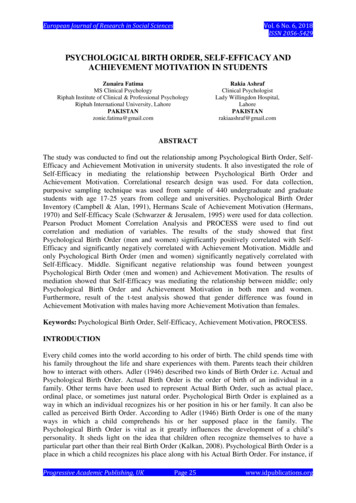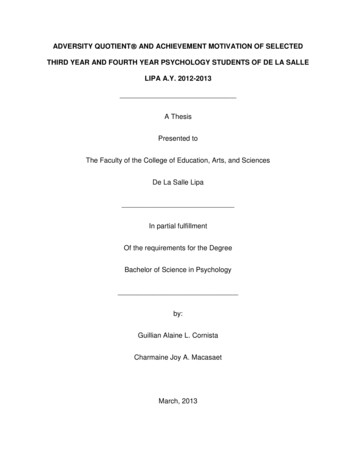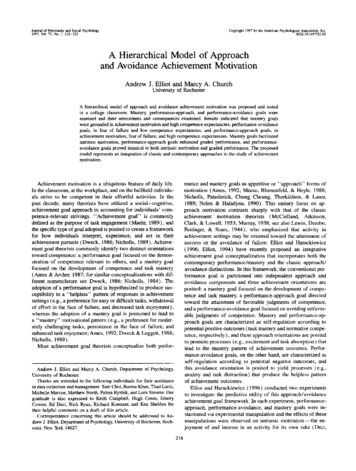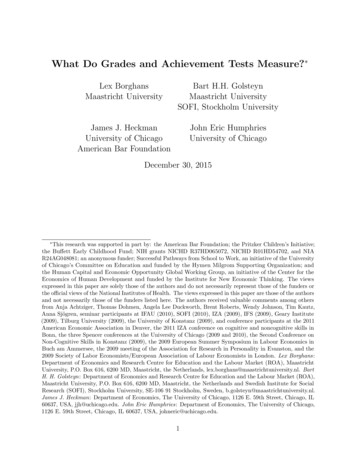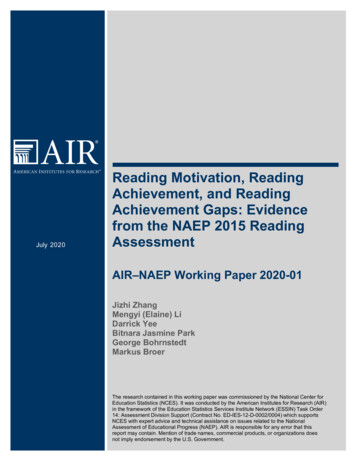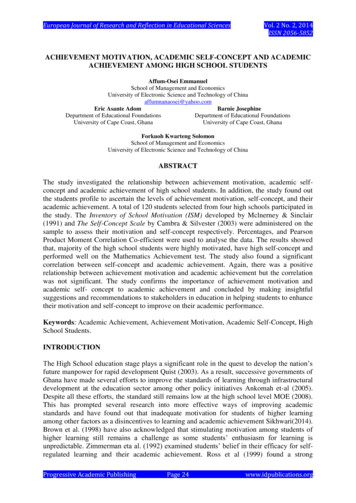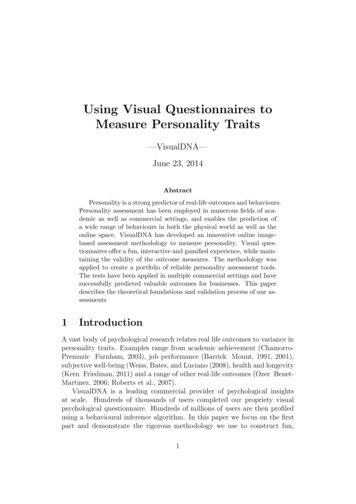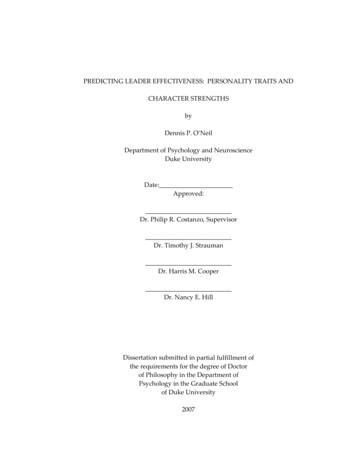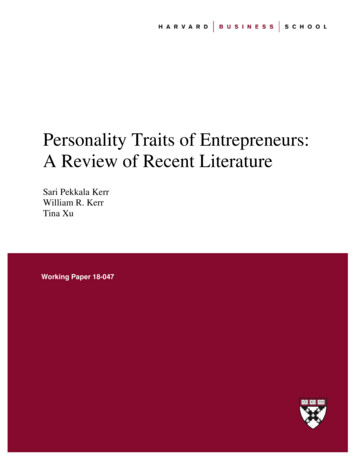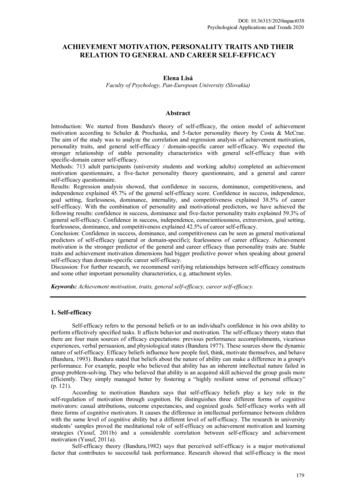
Transcription
DOI: 10.36315/2020inpact038Psychological Applications and Trends 2020ACHIEVEMENT MOTIVATION, PERSONALITY TRAITS AND THEIRRELATION TO GENERAL AND CAREER SELF-EFFICACYElena LisáFaculty of Psychology, Pan-European University (Slovakia)AbstractIntroduction: We started from Bandura's theory of self-efficacy, the onion model of achievementmotivation according to Schuler & Prochaska, and 5-factor personality theory by Costa & McCrae.The aim of the study was to analyze the correlation and regression analysis of achievement motivation,personality traits, and general self-efficacy / domain-specific career self-efficacy. We expected thestronger relationship of stable personality characteristics with general self-efficacy than withspecific-domain career self-efficacy.Methods: 713 adult participants (university students and working adults) completed an achievementmotivation questionnaire, a five-factor personality theory questionnaire, and a general and careerself-efficacy questionnaire.Results: Regression analysis showed, that confidence in success, dominance, competitiveness, andindependence explained 45.7% of the general self-efficacy score. Confidence in success, independence,goal setting, fearlessness, dominance, internality, and competitiveness explained 38.5% of careerself-efficacy. With the combination of personality and motivational predictors, we have achieved thefollowing results: confidence in success, dominance and five-factor personality traits explained 59.3% ofgeneral self-efficacy. Confidence in success, independence, conscientiousness, extraversion, goal setting,fearlessness, dominance, and competitiveness explained 42.5% of career self-efficacy.Conclusion: Confidence in success, dominance, and competitiveness can be seen as general motivationalpredictors of self-efficacy (general or domain-specific); fearlessness of career efficacy. Achievementmotivation is the stronger predictor of the general and career efficacy than personality traits are. Stabletraits and achievement motivation dimensions had bigger predictive power when speaking about generalself-efficacy than domain-specific career self-efficacy.Discussion: For further research, we recommend verifying relationships between self-efficacy constructsand some other important personality characteristics, e.g. attachment styles.Keywords: Achievement motivation, traits, general self-efficacy, career self-efficacy.1. Self-efficacySelf-efficacy refers to the personal beliefs or to an individual's confidence in his own ability toperform effectively specified tasks. It affects behavior and motivation. The self-efficacy theory states thatthere are four main sources of efficacy expectations: previous performance accomplishments, vicariousexperiences, verbal persuasion, and physiological states (Bandura 1977). These sources show the dynamicnature of self-efficacy. Efficacy beliefs influence how people feel, think, motivate themselves, and behave(Bandura, 1993). Bandura stated that beliefs about the nature of ability can make a difference in a group'sperformance. For example, people who believed that ability has an inherent intellectual nature failed ingroup problem-solving. They who believed that ability is an acquired skill achieved the group goals moreefficiently. They simply managed better by fostering a “highly resilient sense of personal efficacy”(p. 121).According to motivation Bandura says that self-efficacy beliefs play a key role in theself-regulation of motivation through cognition. He distinguishes three different forms of cognitivemotivators: casual attributions, outcome expectancies, and cognized goals. Self-efficacy works with allthree forms of cognitive motivators. It causes the difference in intellectual performance between childrenwith the same level of cognitive ability but a different level of self-efficacy. The research in universitystudents’ samples proved the meditational role of self-efficacy on achievement motivation and learningstrategies (Yusuf, 2011b) and a considerable correlation between self-efficacy and achievementmotivation (Yusuf, 2011a).Self-efficacy theory (Bandura,1982) says that perceived self-efficacy is a major motivationalfactor that contributes to successful task performance. Research showed that self-efficacy is the most179
p-ISSN: 2184-2205 e-ISSN: 2184-3414 ISBN: 978-989-54312-9-8 2020important predictor of university student achievement (Bartimote-Aufflick, Bridgeman, Walker, Sharma,& Smith, 2016). Bandura understands motivation as a cognitive phenomenon and the self-efficacy in thesame way. He said: “Expectations of personal efficacy do not operate as dispositional determinantsindependently of contextual factors.” (Bandura, 1977, p. 203). Hence, it is necessary for a subject toidentify the circumstance and to determine the required behavior. The dynamic nature of self-efficacy istherefore used for developmental goals in various settings, e.g. schools (Bartimote-Aufflick, et al., 2016).An example of a domain-specific self-efficacy is a also career self efficacy. It is broadly defined as“confidence in one’s ability to manage career development and work-related tasks” (O’Brien, 2003,p. 110).When speaking about achievement and motivation we cannot forget dispositional theories. Fromthat point of view, achievement motivation is a personality variable that has been used to explainindividual differences in various contexts. It can be regarded as a complex construct consisting ofdifferent layers of dimensions, something as onion. Schuler & Prochaska (2011) view achievementmotivation model as an onion model. Layers of onion are layers of personality: background variables(neuroticism, conscientiousness), theoretical compounds (locus of control, attribution style,self-confidence), peripheral facets (independence, status orientation), core facets (hope of success, goalsetting, persistence). Therefore “it is regarded as a general orientation of the person towards theachievement” (p.9).In spite of the fact, that self-efficacy is the dynamic cognitive construct, research in last yearsshowed that personality traits contribute as antecedents to domain-specific kinds of self-efficacy,e.g. career self-efficacy (Brown & Cinamon, 2016; Hartman & Betz, 2007; Bullock-Yowell, Andrews,& Buzzetta, 2011), computer self-efficacy (Saleem, Beaudry, & Croteau, 2011), creative self‐efficacy(Karwowski, Lebuda, Wisniewska, & Gralewski, 2013), entrepreneurial self-efficacy (Şahin, Karadağ,& Tuncer, 2019). These findings are important in light of the integration of trait and social-cognitiveperspectives.2. ObjectivesWe expect a significant relationship between the stable characteristics of personality andself-efficacy constructs. When considering the power of the situation in case of domain-specificself-efficacy constructs, we expect that the relationship between stable personality characteristics(achievement motivation, and personality traits) and generalized efficacy will be stronger than betweenstable personality characteristics (achievement motivation, and personality traits) and career self-efficacy.3. MethodsSeven hundred and thirteen university students and adults participated in the research.All participants took achievement motivation inventory, 690 of them fulfilled career efficacyquestionnaire, 600 five-factor personality inventory, 268 general self-efficacy scale. The participants werecollected by the snowball method. The first contact - psychology students collected the data and theyreceived the credits for a research practice course. The data were collected and processed anonymously.Participation in the research was voluntary.Achievement motivation inventory (LMI; Schuller & Prochaska, 2011) in the Slovak languagecontains 170 items in a 7-point Likert format from (1) “Does not apply at all” to (7) “Applies fully tome”. The final questionnaire consists from 17 dimensions - Fearlessness, Flexibility, Independence,Preference for Difficult Tasks, Confidence in Success, Dominance, Goal Setting, Eagerness to Learn,Competitiveness, Compensatory Effort, Engagement, Pride in Productivity, Status Orientation, Flow,Internality, Persistence, Self-Control.Generalized Self-Efficacy Scale (GSES) was confirmed as a cultural independent tool in 25countries of the world (Luszczynska, Scholz, & Schwarzer, 2005; Scholz, Gutiérrez-Doña, Sud,& Schwarzer, 2002). For the research purpose, we used the Slovak version of the GSES (Košč, Heftyová,Schwarzer, & Jerusalem, 1993). It contains 10 items in a 4-point Likert format from (1) “Not true” to (7)“The truth”.The Career Decision Self-Efficacy scale–Short Form (CDSES; Betz, Klein, & Taylor in O’Brien,2003) is a self-report, 25-item inventory developed to assess confidence in making career-relateddecisions and engaging in tasks related to career decision making. A 5-point continuum, ranging from noconfidence at all (1) to complete confidence (5) was used. All items were summed to obtain the total scoreon the CDSES–SF. High scores reflect strong levels of confidence in completing career-related tasks.NEO the five-factor personality inventory NEO-FFI represents a shortened version of thefive-factor personality theory questionnaire (Ruisel & Halama, 2007) that measures five main personalitytraits: neuroticism, extraversion, openness to experience, agreeableness, and conscientiousness.The dimensions represent the sum of answers for 12 questions using ratings from 1 to 5.180
Psychological Applications and Trends 2020The data were analyzed by JASP 0.11.1.0 (correlation, and regression analysis). The study is partof the research project GA AA 3 5/2020.4. ResultsCorrelation analysis showed small to large correlation coefficients between self-efficacy,personality traits and achievement motivation dimensions (Table 1).Five achievement motivation dimensions predict general self-efficacy: dominance, confidence insuccess, flexibility, competitiveness, and goal setting. The regression model explains 48,3 % of generalself-efficacy score variability (R 0,695; R2 0,483; F (17 240) 13,192; p .001).All five personality traits in combination with four dimensions of achievement motivation(dominance, confidence in success, self-control, and competitiveness) significantly predict generalself-efficacy. The regression model explains 61,3 % of general self-efficacy score variability (R 0,783;R2 0,613; F (22 226) 16,297; p .001).Nine achievement motivation dimensions (dominance, confidence in success, flexibility,fearlessness, internality, eagerness to learn, preference for difficult tasks, competitiveness, and goalsetting) significantly predict career self-efficacy. The regression model explains 39,7 % of careerself-efficacy score variability (R 0,630; R2 0,397; F (17 655) 25,380; p .001).Three traits of personality (extraversion, agreeableness, and conscientiousness) with sixachievement motivation dimensions (dominance, engagement, confidence in success, fearlessness,competitiveness, and goal setting) significantly predict career self-efficacy score. The regressionmodel explains 44,4 % of career self-efficacy score (R 0,666; R2 0,444; F (22 537) 19,467;p .001).5. DiscussionStable traits and achievement motivation dimensions significantly predict both, general andcareer self-efficacy. They had bigger predictive power when speaking about general self-efficacy thanabout domain-specific career self-efficacy. Achievement motivation is the stronger predictor of thegeneral and career efficacy than personality traits are. When speaking about the general self-efficacyscore, all five personality traits predict the overall score. In comparison with that, only three personalitytraits predict the domain-specific career self-efficacy score. It agrees with Bandura s (1993) statement,that domain-specific efficacy constructs depend more on the situation. Dominance, confidence in successand competitiveness as the achievement motivation dimensions can be seen as general motivationalpredictors of self-efficacy, whether general or career. These motivational dimensions of the LMIquestionnaire belong to the most stable ones (Prochaska & Schuler, 2011). Dominance reflects a tendencyto exercise power and influence others. Confidence in success reflects a tendency to achieve success evenwhen there are obstacles to overcome. This phenomenon described Bandura (1993) as a key behavioralstrategy of highly efficient thinking. Competitiveness expresses the desire to win and be better and fasterthan others. Dimension fearlessness was included in career self-efficacy predictive models and it was notsignificant in the general self-efficacy regression model. Fearlessness expresses a lack of fear of failing atdifficult tasks, or of being judged by others (Schuler & Prochaska, 2011).There are also other studies that showed a significant relationship between self-efficacy andachievement motivation. Small to medium correlation between self-efficacy and achievement motivationwas found (Liqin & Lesen, 2018; Harahsheh, 2017; Jalal, Mansor, & Arshadi, 2016), but also nosignificant correlation (Sharma, 2015; Zhang, Zhang, Zhang, Liu, Zhang, Wang, & Liu, 2015).The relatively strong predictive power in the current study can be caused by the stable nature of LMIachievement motivation dimensions.Relationships between self-efficacy and achievement motivation were recently examined in thecontext of various variables, e. g. negligence (Jalal, et al., 2016), self-identity and hope (Liqin, Lesen,2018). For further research, we recommend verifying relationships between self-efficacy constructs andsome other important personality characteristics, e.g. attachment (Klanduchová & Greškovičová, 2019;Greškovičová & Hírešová, 2019).ReferencesBandura, A. (1977). Self-efficacy: Toward a unifying theory of behavioral change. Psychological Review84 (2), 191- 215.Bandura, A. (1982). Self-efficacy mechanisms in human agency. American Psychologist, 37 (2),122–147.181
p-ISSN: 2184-2205 e-ISSN: 2184-3414 ISBN: 978-989-54312-9-8 2020Bandura, A. (1993). Perceived Self-Efficacy in Cognitive Development and Functioning. EducationalPsychologist, 28 (2), 117-148.Bartimote-Aufflick, K., Bridgeman, A., Walker, R., Sharma, M., Smith, L. (2016). The study, evaluation,and improvement of university student self-efficacy. Studies in Higher Education, 41 (11),1918–1942.Brown, D., & Cinamon, R. G. (2016). Personality traits’ effects on self-efficacy and outcome expectationsfor high school major choice. International Journal for Educational and Vocational Guidance, 16,343–361.Bullock-Yowell, E., Andrews, L., & Buzzetta, M. E. (2011). Explaining career decision-making selfefficacy: Personality, cognitions, and cultural mistrust. Career Development Quarterly, 59 (5),400–411.Greškovičová, K., Hírešová, I. (2019). Conference: CER Comparative European Research 2019. London:Sciemcee Publishing, 122-125.Harahsheh, A. H. (2017). Perceived Self-Efficacy and Its Relationship to Achievement Motivation amongParallel Program Students at Prince Sattam University. International Journal of PsychologicalStudies, 9 (3), Retrieved 03 23, 2020, from: http://doi.org/10.5539/ijps.v9n3p21.Hartman, R. O., & Betz, N. E. (2007). The five-factor model and career self-efficacy: General anddomain-specific relationships. Journal of Career Assessment, 15, 145–161.Jalal, P., K., Mansor, M. S., Arshadi, F. K. (2016). The Relationship between Self-Efficacy, AchievementMotivation and Negligence in Students. International Journal of Humanities and Cultural Studies,6 (3), 1788-1799.Karwowski, M., Lebuda, I., Wisniewska, E., Gralewski, J. (2013). Big Five Personality Traits as thePredictors of Creative Self‐Efficacy and Creative Personal Identity: Does Gender Matter? Journalof Creative Behavior, 47 (3), 215-232.Klanduchová, E., Greškovičová, K. (2019). Time perspective and bonding. Conference: CERComparative European Research 2019. London: Sciemcee Publishing, 118-121.Košč, M., Heftyová, E., Schwarzer, R., Jerusalem M. (1993). Slovakian Adaptation of the GeneralSelf-Efficacy Scale. Retrieved 03 23, 2020, from: http://userpage.fu-berlin.de/ health/slovak.htmLiqin, L., Lesen, Ch. (2018). The Relationship Between Self-Efficacy and Achievement Motivation inAdolescents: A Moderated Mediating Model of Self-Identity and Hope, Psychology andBehavioral Sciences, 7 (3), 69-76.Luszczynska, A., Scholz, U., Schwarzer, R. (2005). The general self-efficacy scale: Multiculturalvalidation studies. The Journal of Psychology, 139 (5), 439-457.O’Brien, K. M. (2003). Measuring career self-efficacy: Promoting confidence and happiness at work.In S. J. Lopez & C. R. Snyder (Eds.), Positive Psychological Assessment: A Handbook of Modelsand Measures (109-126). Washington, DC, US: American Psychological Association.Ruisel, I., & Halama, P. (2007). NEO-FFI: NEO päťfaktorový osobnostný inventár. Praha: Hogrefe Testcentrum.Şahin, F., Karadağ, H., Tuncer, B. (2019). Big five personality traits, entrepreneurial self-efficacy andentrepreneurial intention: A configurational approach. International Journal of EntrepreneurialBehavior & Research, 25 (6), 1188-1211.Saleem, H., Beaudry, A., Croteau, A. M. (2011). Antecedents of computer self-efficacy: A study of therole of personality traits and gender. Computers in Human Behavior, 27 (5), 1922-1936.Scholz, U., Gutiérrez-Doña, B., Sud, S., Schwarzer, R. (2002). Is general self-efficacy a universalconstruct? Psychometric findings from 25 countries. European Journal of PsychologicalAssessment, 18 (3), 242-251.Schuler, H., & Prochaska, M. (2011). Dotazník motivácie k výkonu - LMI. Praha: Hogrefe - Testcentrum.Sharma, K. (2015). A study of self-efficacy and achievement motivation of prospective teachers inrelation to their attitude towards teaching. Scholarly Research Journal for InterdisciplinaryStudies, 3 (18), 53-57.Yusuf, M. (2011a). Investigating relationship between self-efficacy, achievement motivation, andself-regulated learning strategies of undergraduate Students: a study of integrated motivationalmodels. Procedia Social and Behavioral Sciences, 15, 2614–2617.Yusuf, M. (2011b). The impact of self-efficacy, achievement motivation, and selfregulated learningstrategies on students’ academic achievement. Procedia Social and Behavioral Sciences, 15,2623–2626.Zhang, Z.-J., Zhang, Ch.-L., Zhang, X.-G., Liu, X.-M., Zhang, H., Wang, J., Liu, S. (2015). Relationshipbetween self-efficacy beliefs and achievement motivation in student nurses. Chinese NursingResearch, 2 (2-3), 67-70.182
Psychological Applications and Trends 2020Table 1. Correlations.1 CDSES2 GSES3N4E5O6P7S8 PE9 DO10 EN11 CS12 FX13 FL14 F15 IN16 CE17 PP18 EL19 PT20 ID21 SC22 OS23 CO24 GS12—0.648 ***—-0.381 *** -0.456 ***0.386 *** 0.464 ***0.162 *** 0.212 ***-0.004-0.158 *0.424 *** 0.456 ***0.392 *** 0.421 ***0.461 *** 0.548 ***0.248 *** 0.266 ***0.514 *** 0.592 ***0.458 *** 0.493 ***0.219 *** 0.238 ***0.427 *** 0.423 ***0.310 *** 0.180 **0.115 **0.0840.279 *** 0.245 ***0.394 *** 0.301 ***0.392 *** 0.455 ***0.461 *** 0.528 ***0.260 *** 0.167 **0.226 *** 0.235 ***0.132 *** 0.0840.407 *** 0.382 ***34—-0.409 ***—-0.0420.207 ***-0.178 *** 0.154 ***-0.366 *** 0.298 ***-0.478 *** 0.301 ***-0.348 *** 0.475 ***-0.126 **0.180 ***-0.452 *** 0.394 ***-0.425 *** 0.460 ***-0.0500.159 ***-0.575 *** 0.280 ***-0.395 *** 0.172 ***0.121 ** -0.026-0.0640.194 ***-0.230 *** 0.209 ***-0.380 *** 0.245 ***-0.508 *** 0.326 ***-0.255 *** 0.086 *0.0240.242 ****0.0930.178 ***-0.157 *** 0.264 ***567891011—0.100 *0.0360.0030.241 ***0.0320.180 ***0.257 ***0.213 ***0.110 **0.150 ***0.0120.120 **0.334 ***0.178 ***0.167 ***0.0160.117 **0.0640.226 ***—0.229 ***0.045-0.214 ***-0.0800.0070.035-0.0700.0030.254 ***0.0080.0390.008-0.051-0.0200.207 ***-0.243 ***-0.313 ***-0.037—0.531 ***0.263 ***0.410 ***0.427 ***0.306 ***0.224 ***0.320 ***0.359 ***0.256 ***0.411 ***0.332 ***0.371 ***0.401 ***0.613 ***0.0500.0080.328 ***—0.415 ***0.449 ***0.534 ***0.447 ***0.243 ***0.603 ***0.441 ***0.155 ***0.296 ***0.349 ***0.556 ***0.534 ***0.543 ***0.0690.074 *0.282 ***—0.396 ***0.594 ***0.495 ***0.345 ***0.377 ***0.165 ***0.178 ***0.404 ***0.471 ***0.484 ***0.531 ***0.159 ***0.478 ***0.456 ***0.467 ***—0.409 ***0.208 ***0.446 ***0.195 ***0.125 ***0.394 ***0.421 ***0.443 ***0.482 ***0.322 ***0.402 ***0.245 ***0.304 ***0.426 ***—0.559 ***0.398 ***0.490 ***0.285 ***0.274 ***0.475 ***0.519 ***0.628 ***0.539 ***0.307 ***0.348 ***0.255 ***0.492 ***Table 1. Correlations – continue.12 FX13 FL14 F15 IN16 CE17 PP18 EL19 PT20 ID21 SC22 OS23 CO24 GS12—0.320 ***0.539 ***0.351 ***0.0570.319 ***0.471 ***0.602 ***0.566 ***0.198 ***0.249 ***0.142 ***0.451 ***13—0.0440.124 ***0.373 ***0.593 ***0.391 ***0.491 ***0.283 ***0.131 ***0.344 ***0.384 ***0.406 ***1415—0.476 ***—-0.218 *** -0.010-0.0060.186 ***0.297 *** 0.217 ***0.537 *** 0.296 ***0.626 *** 0.416 ***0.318 *** 0.398 ***-0.059-0.077 *-0.068-0.098 **0.201 *** 0.182 ***16171819—0.578 ***0.287 ***0.193 ***0.0070.274 ***0.372 ***0.373 ***0.361 ***—0.408 ***0.349 ***0.260 ***0.283 ***0.527 ***0.445 ***0.517 ***—0.547 ***0.409 ***0.267 ***0.345 ***0.287 ***0.547 ***—0.584 ***0.313 ***0.209 ***0.221 ***0.475 ***20212223—0.298 ***—0.129 *** -0.012—0.099 ** -0.0180.666 ***—0.379 *** 0.232 *** 0.578 *** 0.445 ****p .05, ** p .01, *** p .001CDSES career self-efficacy; GSES general self-efficacy; N neuroticism; E extraversion; O openness toexperience; A agreeableness; C conscientiousness; F fearlessness; FX Flexibility; ID Independence;PT Preference for Difficult Tasks; CS Confidence in Success; DO Dominance; GS Goal Setting;EL Eagerness to Learn; CO Competitiveness; CE Compensatory Effort; EN Engagement; PP Pride inProductivity; OS Status Orientation; FL Flow; IN Internality; PE Persistence; SC Self-Control.183
Stable traits and achievement motivation dimensions significantly predict both, general and career self-efficacy. They had bigger predictive power when speaking about general self-efficacy than about domain-specific career self-efficacy. Achievement motivation is the stronger predictor of the general and career efficacy than personality traits are.
